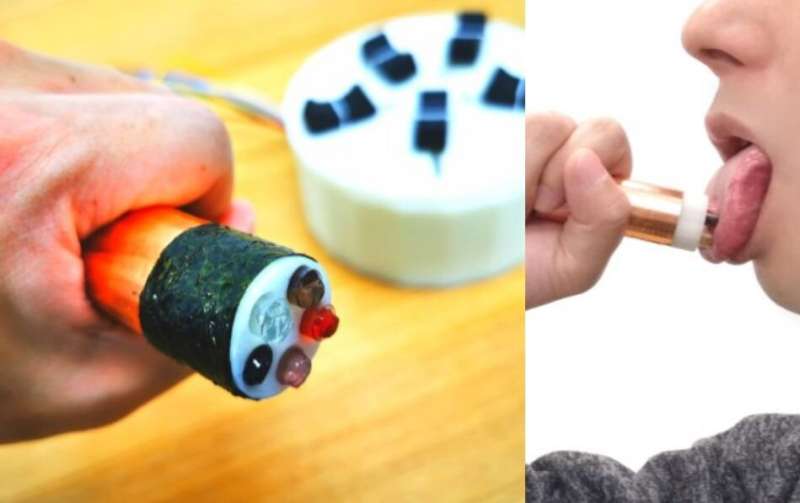May 25, 2020 report
Digital device serves up a taste of virtual food

We're used to measuring our digital devices by how fast they are, how clear the sound is, how crisp the display is, how large the storage capacity is.
Some day soon, if Homei Miyashita has his way, we may measure them by how delicious they are.
The Meiji University researcher has developed a handheld "lickable screen" device that, when inserted into your mouth, can recreate all taste sensations associated with food.
Th device relies on electrolytes inserted into five gels controlling the intensity of the five basic flavors: sour, sweet, bitter, salt and umami. The lesser-known term umami, derived from the Japanese word for a pleasant savory taste, was added to the basic tastes group relatively recently, in 1990.
The process employs electrophoresis, the migration of microscopic particles activated by an electric charge. When the five-tube device touches the tongue, the subject perceives all five taste sensations. But when variously measured electrical charges are applied (in low enough voltage to do no harm), some tastes can be heightened while others recede.
Miyashita compared the manipulation of taste perception to our perceptions of images on video monitors. Our eyes view beautiful images on the screen, but in fact they are merely a series of continuously pulsating red, green and blue pixels of varying combinations and intensities.
"Like an optical display that uses lights of three basic colors to produce arbitrary colors," Miyashita said in his research paper published on the Meiji University web site, "this display can synthesize and distribute arbitrary tastes together with the data acquired by taste sensors."
He termed his device the Norimaki Synthesizer. Norimaki are a type of seaweed wrapped around sushi. In fact, in one of his experiments, Miyashita enhanced the subject's experience by wrapping the synthesizer in dried seaweed as he boosted the salt and sour tastes to more closely mimic the sensation of consuming sushi.
The synthesizer, Miyashita said, "has allowed users to experience the flavor of everything from gummy candy to sushi without having to place a single item of food in their mouths."
The concept promises great pleasure to passengers on no-frills flights, for instance, who could enjoy a flavorful virtual steak or ice-cream sundae with no muss and no fuss. Of course, when and if it is introduced into the general population, early pioneers may well draw curious stares from neighboring passengers if they whip out their computer devices and start licking them.
But aside from its entertainment value, the Norimaki Synthesizer may prove to be an invaluable tool for those working on weight management. Others, for example, such as those with hypertension who must restrict salt intake, might combine real food while employing the device that adds virtual salt to their heart's content.
In his abstract, Miyashita acknowledged his interest was spurred by earlier research efforts of Hiromi Nakamura, who in 2011 achieved "augmented gustation" by sending electrical charges through chop sticks, forks and straws to create tastes humans could not perceive solely with their tongues.
These efforts are reminiscent of similar efforts to apply not taste but smell to augment a subject's experience.
In 1959, Charles Weiss, a public relations executive, created AromaRama that distributed scents of grass, exploding firecrackers, incense, burning torches and horses through the theater's air-conditioning system during the first showing of "Behind the Great Wall." But the effort spurred legendary New York Times movie critic Bosley Crowther to write: "Check off the novel experience as… a stunt. The artistic benefit of it is here demonstrated to be nil."
The next year, inventor Hans Laube introduced a supposedly improved Smell-O-Vision with the release of his movie "Scent of Mystery" where the thriller was augmented by smells such as freshly baked bread, wine, an ocean breeze or a skunk delivered through beneath-the-seat tubes. Certain smells offered clues to imminent activity on the screen, such as pipe tobacco smoke that was released whenever the killer appeared. But viewers complained of uneven or delayed distribution of smells, and the distracting noises of viewers struggling to sniff each scent. For fans and critics, the movie was a stinker. Famed comedian Henry Youngman quipped, "I didn't understand the picture. I had a cold."
More information: research.miyashita.com/papers/I42
Norimaki Synthesizer: Taste Display Using Ion Electrophoresis in Five Gels, CHI EA '20: Extended Abstracts of the 2020 CHI Conference on Human Factors in Computing Systems, April 2020. dl.acm.org/doi/abs/10.1145/3334480.3382984
© 2020 Science X Network
















